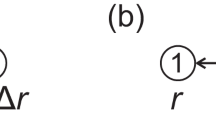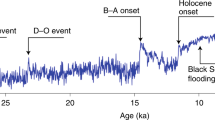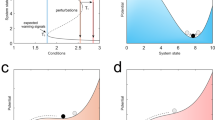Abstract
Complex dynamical systems, ranging from ecosystems to financial markets and the climate, can have tipping points at which a sudden shift to a contrasting dynamical regime may occur. Although predicting such critical points before they are reached is extremely difficult, work in different scientific fields is now suggesting the existence of generic early-warning signals that may indicate for a wide class of systems if a critical threshold is approaching.
This is a preview of subscription content, access via your institution
Access options
Subscribe to this journal
Receive 51 print issues and online access
$199.00 per year
only $3.90 per issue
Buy this article
- Purchase on Springer Link
- Instant access to full article PDF
Prices may be subject to local taxes which are calculated during checkout





Similar content being viewed by others
References
Venegas, J. G. et al. Self-organized patchiness in asthma as a prelude to catastrophic shifts. Nature 434, 777–782 (2005)
Litt, B. et al. Epileptic seizures may begin hours in advance of clinical onset: a report of five patients. Neuron 30, 51–64 (2001)
McSharry, P. E., Smith, L. A. & Tarassenko, L. Prediction of epileptic seizures: are nonlinear methods relevant? Nature Med. 9, 241–242 (2003)
Kambhu, J., Weidman, S. & Krishnan, N. New Directions for Understanding Systemic Risk: A Report on a Conference Cosponsored by the Federal Reserve Bank of New York and the National Academy of Sciences (The National Academies Press, 2007)
May, R. M., Levin, S. A. & Sugihara, G. Ecology for bankers. Nature 451, 893–895 (2008)
Lenton, T. M. et al. Tipping elements in the Earth’s climate system. Proc. Natl Acad. Sci. USA 105, 1786–1793 (2008)
Scheffer, M. et al. Catastrophic shifts in ecosystems. Nature 413, 591–596 (2001)
Millennium Ecosystem Assessment. Ecosystems and Human Well-being: Synthesis Report (Island, 2005)
Schroeder, M. Fractals, Chaos, Power Laws: Minutes from an Infinite Paradise (Freeman, 1991)
Kuznetsov, Y. A. Elements of Applied Bifurcation Theory (Springer, 1995)
Scheffer, M. Critical Transitions in Nature and Society (Princeton Univ. Press, 2009)This book is an introduction to the theory of critical transitions with examples from ecosystems, climate dynamics and social systems.
Wissel, C. A universal law of the characteristic return time near thresholds. Oecologia 65, 101–107 (1984)
Zahler, R. S. & Sussmann, H. J. Claims and accomplishments of applied catastrophe theory. Nature 269, 759–763 (1977)
Bagowski, C. P. & Ferrell, J. E. Bistability in the JNK cascade. Curr. Biol. 11, 1176–1182 (2001)
May, R. M. Thresholds and breakpoints in ecosystems with a multiplicity of stable states. Nature 269, 471–477 (1977)
Van Nes, E. H. & Scheffer, M. Slow recovery from perturbations as a generic indicator of a nearby catastrophic shift. Am. Nat. 169, 738–747 (2007)This paper shows that recovery rate after disturbances is a good indicator of the proximity of a critical threshold.
Ovaskainen, O. & Hanski, I. Transient dynamics in metapopulation response to perturbation. Theor. Popul. Biol. 61, 285–295 (2002)
Ives, A. R. Measuring resilience in stochastic systems. Ecol. Monogr. 65, 217–233 (1995)
Kleinen, T., Held, H. & Petschel-Held, G. The potential role of spectral properties in detecting thresholds in the Earth system: application to the thermohaline circulation. Ocean Dyn. 53, 53–63 (2003)
Livina, V. N. & Lenton, T. M. A modified method for detecting incipient bifurcations in a dynamical system. Geophys. Res. Lett. 34, L03712 (2007)
Held, H. & Kleinen, T. Detection of climate system bifurcations by degenerate fingerprinting. Geophys. Res. Lett. 31, L23207 (2004)This paper shows that autocorrelation increases in the vicinity of a bifurcation in a model of the thermohaline circulation.
Dakos, V. et al. Slowing down as an early warning signal for abrupt climate change. Proc. Natl Acad. Sci. USA 105, 14308–14312 (2008)This paper shows that autocorrelation increased before eight well-known climate transitions in the past, and describes the methodology of data processing required to do such an analysis.
Lenton, T. M. et al. Using GENIE to study a tipping point in the climate system. Phil. Trans. R. Soc. A 367, 871–884 (2009)
Carpenter, S. R. & Brock, W. A. Rising variance: a leading indicator of ecological transition. Ecol. Lett. 9, 308–315 (2006)This paper shows that variance increases in the vicinity of a bifurcation in a lake model.
Biggs, R., Carpenter, S. R. & Brock, W. A. Turning back from the brink: detecting an impending regime shift in time to avert it. Proc. Natl Acad. Sci. USA 106, 826–831 (2009)
Berglund, N. & Gentz, B. Metastability in simple climate models: pathwise analysis of slowly driven Langevin equations. Stoch. Dyn. 2, 327–356 (2002)
Berglund, N. & Gentz, B. Noise-Induced Phenomena in Slow-Fast Dynamical Systems - A Sample-Paths Approach (Springer, 2006)
Guttal, V. & Jayaprakash, C. Changing skewness: an early warning signal of regime shifts in ecosystems. Ecol. Lett. 11, 450–460 (2008)
Horsthemke, W. & Lefever, R. Noise-Induced Transitions: Theory and Applications in Physics, Chemistry, and Biology (Springer, 1984)
Carpenter, S. R. et al. Leading indicators of trophic cascades. Ecol. Lett. 11, 128–138 (2008)
Strogatz, S. H. Nonlinear Dynamics and Chaos - With Applications to Physics, Biology, Chemistry and Engineering 1st edn 248–254 (Addison-Wesley, 1994)
Chisholm, R. A. & Filotas, E. Critical slowing down as an indicator of transitions in two-species models. J. Theor. Biol. 257, 142–149 (2009)
Vandermeer, J. & Yodzis, P. Basin boundary collision as a model of discontinuous change in ecosystems. Ecology 80, 1817–1827 (1999)
Rinaldi, S. & Scheffer, M. Geometric analysis of ecological models with slow and fast processes. Ecosystems 3, 507–521 (2000)
Vandermeer, J., Stone, L. & Blasius, B. Categories of chaos and fractal basin boundaries in forced predator-prey models. Chaos Solitons Fractals 12, 265–276 (2001)
Leung, H. K. Bifurcation of synchronization as a nonequilibrium phase transition. Physica A 281, 311–317 (2000)
Scheffer, M., Westley, F. & Brock, W. Slow response of societies to new problems: causes and costs. Ecosystems 6, 493–502 (2003)
Holyst, J. A., Kacperski, K. & Schweitzer, F. Social impact models of opinion dynamics. Annu. Rev. Comput. Phys. 9, 253–273 (2002)
Bascompte, J. & Solé, R. V. Habitat fragmentation and extinction thresholds in spatially explicit models. J. Anim. Ecol. 65, 465–473 (1996)
Hanski, I. Metapopulation dynamics. Nature 396, 41–49 (1998)
Solé, R. V. et al. Phase transitions and complex systems. Complexity 1, 13–26 (1996)
Kefi, S. et al. Spatial vegetation patterns and imminent desertification in Mediterranean arid ecosystems. Nature 449, 213–217 (2007)
Turing, A. M. The chemical basis of morphogenesis. Phil. Trans. R. Soc. Lond. B 237, 37–72 (1952)
Rietkerk, M., Dekker, S. C., de Ruiter, P. C. & van de Koppel, J. Self-organized patchiness and catastrophic shifts in ecosystems. Science 305, 1926–1929 (2004)This paper discusses how self-organized vegetation patterns may indicate the vicinity of a catastrophic bifurcation in which all vegetation is lost.
Tredicce, J. R. et al. Critical slowing down at a bifurcation. Am. J. Phys. 72, 799–809 (2004)
Matsumoto, G. & Kunisawa, T. Critical slowing-down near the transition region from the resting to time-ordered states in squid giant axons. J. Phys. Soc. Jpn 44, 1047–1048 (1978)
Alley, R. B. et al. Abrupt climate change. Science 299, 2005–2010 (2003)
Tripati, A., Backman, J., Elderfield, H. & Ferretti, P. Eocene bipolar glaciation associated with global carbon cycle changes. Nature 436, 341–346 (2005)
Kump, L. R. Foreshadowing the glacial era. Nature 436, 333–334 (2005)
Liu, Z. et al. Global cooling during the Eocene-Oligocene climate transition. Science 323, 1187–1190 (2009)
Petit, J. R. et al. Climate and atmospheric history of the past 420,000 years from the Vostok ice core, Antarctica. Nature 399, 429–436 (1999)
Lüthi, D. et al. High-resolution carbon dioxide concentration record 650,000–800,000 years before present. Nature 453, 379–382 (2008)
Rahmstorf, S. Bifurcations of the Atlantic thermohaline circulation in response to changes in the hydrological cycle. Nature 378, 145–149 (1995)
Bakke, J. et al. Rapid oceanic and atmospheric changes during the Younger Dryas cold period. Nature Geosci. 2, 202–205 (2009)
Clark, P. U., Pisias, N. G., Stocker, T. F. & Weaver, A. J. The role of the thermohaline circulation in abrupt climate change. Nature 415, 863–869 (2002)
Crowley, T. J. & Hyde, W. T. Transient nature of late Pleistocene climate variability. Nature 456, 226–230 (2008)
Scheffer, M. & van Nes, E. H. Shallow lakes theory revisited: various alternative regimes driven by climate, nutrients, depth and lake size. Hydrobiologia 584, 455–466 (2007)
Scheffer, M. & Carpenter, S. R. Catastrophic regime shifts in ecosystems: linking theory to observation. Trends Ecol. Evol. 18, 648–656 (2003)
Hsieh, C. H. et al. Fishing elevates variability in the abundance of exploited species. Nature 443, 859–862 (2006)
Anderson, C. N. K. et al. Why fishing magnifies fluctuations in fish abundance. Nature 452, 835–839 (2008)This paper shows that increased variance in exploited fish stocks may arise from higher growth rates leading to stronger nonlinearity.
Mormann, F., Andrzejak, R. G., Elger, C. E. & Lehnertz, K. Seizure prediction: the long and winding road. Brain 130, 314–333 (2007)
Elger, C. E. & Lehnertz, K. Seizure prediction by non-linear time series analysis of brain electrical activity. Eur. J. Neurosci. 10, 786–789 (1998)
Brock, W., Lakonishok, J. & Lebaron, B. Simple technical trading rules and the stochastic properties of stock returns. J. Finance 47, 1731–1764 (1992)
Lo, A. W., Mamaysky, H. & Wang, J. Foundations of technical analysis: computational algorithms, statistical inference, and empirical implementation. J. Finance 55, 1705–1765 (2000)
Lebaron, B. The stability of moving average technical trading rules on the Dow Jones Index. Deriv. Use Trad. Regul. 5, 324–338 (2000)
Bates, D. S. The crash of 87 - was it expected? The evidence from options markets. J. Finance 46, 1009–1044 (1991)
Bates, D. S. Jumps and stochastic volatility: exchange rate processes implicit in deutsche mark options. Rev. Financ. Stud. 9, 69–107 (1996)
Hens, T. & Schenk-Hoppe, K. R. Handbook of Financial Markets: Dynamics and Evolution (North-Holland, 2009)
Arvedlund, E. Calm before the storm? Low volatility often precedes market downturn. Barron’s (January 28, 2002)
Whaley, R. E. Derivatives on market volatility: hedging tools long overdue. J. Deriv. 1, 71–84 (1993)
Whaley, R. E. The investor fear gauge. J. Portfol. Manage. 26, 12–17 (2000)
Lebaron, B. Some relations between volatility and serial correlations in stock-market returns. J. Bus. 65, 199–219 (1992)
Hong, H. & Stein, J. C. Differences of opinion, short-sales constraints, and market crashes. Rev. Financ. Stud. 16, 487–525 (2003)
Bence, J. R. Analysis of short-time series - correcting for autocorrelation. Ecology 76, 628–639 (1995)
Box, G. E. P., Jenkins, G. M. & Reinsel, G. C. Time Series Analysis: Forecasting and Control (Prentice-Hall, 1994)
Guttal, V. & Jayaprakash, C. Spatial variance and spatial skewness: leading indicators of regime shifts in spatial ecological systems. Theor. Ecol. 11, 450–460 (2008)
Van Nes, E. H. & Scheffer, M. Implications of spatial heterogeneity for regime shifts in ecosystems. Ecology 86, 1797–1807 (2005)
Acknowledgements
Our work was supported by the Institute Para Limes and by the South American Institute for Resilience and Sustainability Studies. The work of S.R.C. is also supported by the US National Science Foundation. The research of M.R. and V.D. is supported by the Netherlands Organisation of Scientific Research, Earth and Life Sciences, in the case of M.R. through a Vidi grant. The work of J.B. is supported by the European Heads of Research Councils, the European Science Foundation and the European Commission Sixth Framework Programme through a European Young Investigator Award. G.S. was supported by Deutsche Bank Jameson Complexity Studies Fund, and by an NSF/NOAA CAMEO Grant NA08OAR4320894.
Author information
Authors and Affiliations
Corresponding author
Rights and permissions
About this article
Cite this article
Scheffer, M., Bascompte, J., Brock, W. et al. Early-warning signals for critical transitions. Nature 461, 53–59 (2009). https://doi.org/10.1038/nature08227
Issue Date:
DOI: https://doi.org/10.1038/nature08227
This article is cited by
-
Phase transitions of civil unrest across countries and time
npj Complexity (2024)
-
Evidence lacking for a pending collapse of the Atlantic Meridional Overturning Circulation
Nature Climate Change (2024)
-
Anticipating regime shifts by mixing early warning signals from different nodes
Nature Communications (2024)
-
Remotely sensing potential climate change tipping points across scales
Nature Communications (2024)
-
Climate-driven invasion and incipient warnings of kelp ecosystem collapse
Nature Communications (2024)
Comments
By submitting a comment you agree to abide by our Terms and Community Guidelines. If you find something abusive or that does not comply with our terms or guidelines please flag it as inappropriate.



